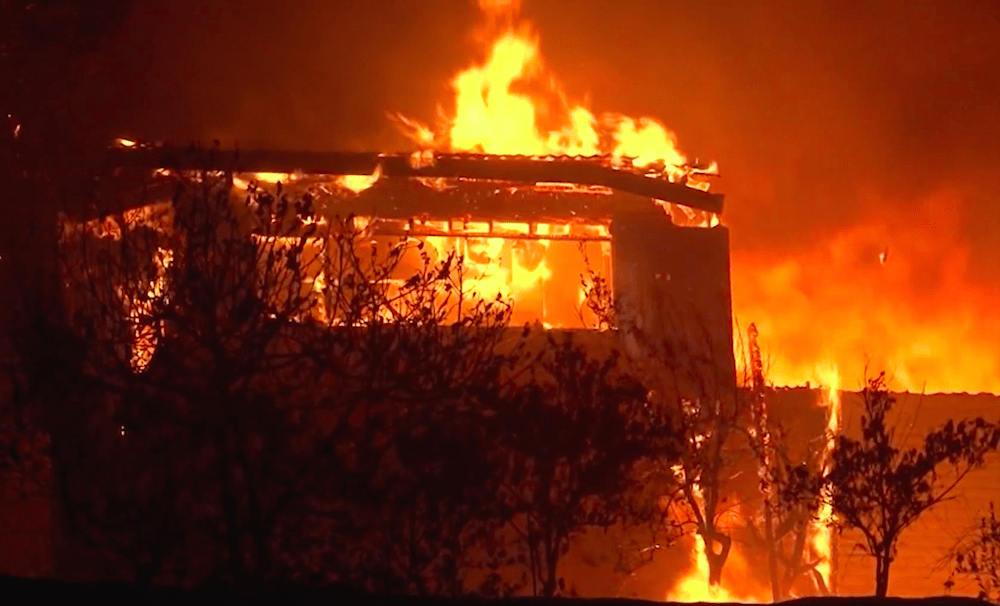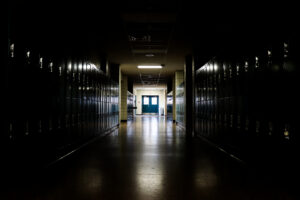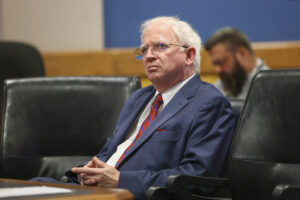At Least 21 Dead in Northern California Infernos [Updated]
More than 3,500 homes and businesses have been destroyed as the catastrophic blazes rage on. Fanned by resurgent high winds, the wildfires, which started Sunday, are out of control and growing in number. (Screen shot via CNN)
Fanned by resurgent high winds, the wildfires, which started Sunday, are out of control and growing in number. (Screen shot via CNN)
SANTA ROSA, Calif. — Friends and relatives desperately checked hospitals and shelters and pleaded on social media for help finding loved ones missing amid California’s wildfires, with hundreds of people unaccounted for Wednesday.
“We’ve been to 17 evacuation centers. We’ve called probably 12 hospitals. I mean, my whole family, all my friends looking for her,” Jessica Tunis said as she searched for her mother, who was last heard saying “I’m going to die” before the phone at her burning mobile home in Santa Rosa went dead.
Hours later Wednesday, the daughter texted a reporter to say that the remains of her mother, 69-year-old Linda Tunis, had been found in the ruins of her home.
As of Wednesday, 22 wildfires were burning in Northern California, up from 17 the day before. The blazes killed at least 21 people and destroyed an estimated 3,500 homes and businesses, many of them in California wine country.
How many people were missing was unclear, and officials said the lists could include duplicated names and people who are safe but haven’t told anyone, whether because of the general confusion or because cellphone service is out across wide areas.
“We get calls and people searching for lost folks and they’re not lost, they’re just staying with somebody and we don’t know where it is,” said Napa County Supervisor Brad Wagenknecht.
With many fires still raging out of control, authorities said locating the missing was not their priority.
Sonoma County Sheriff Robert Giordano put the number of people unaccounted for in the hard-hit county at 380 and said officers were starting limited searches in the “cold zones” they could reach.
“We can only get so many places and we have only so many people to work on so many things,” he said. “When you are working on evacuations, those are our first priority in resources.”
As a result, many people turned to social media, posting pleas such as “Looking for my Grandpa Robert,” ″We are looking for our mother Norma” or “I can’t find my mom.” It is an increasingly familiar practice that was seen after Hurricanes Harvey, Irma and Maria and the Las Vegas massacre.
A sobbing Rachael Ingram searched shelters and called hospitals to try to find her friend Mike Grabow, whose home in Santa Rosa was destroyed. She plastered social media with photos of the bearded man as she drove up and down Highway 101 in her pickup.
Privacy rules, she said, prevented shelters from releasing information.
“You can only really leave notes and just try and send essentially a message in a bottle,” she said.
Ingram said she hopes Grabow is simply without a phone or cell service.
“I’ve heard stories of people being relocated to San Francisco and Oakland. I’m hoping for something like that,” she said. “We’re hearing the worst and expecting the best.”
Frances Dinkelspiel, a journalist in Berkeley, turned to social media for help finding her stepbrother Jim Conley after tweeting authorities and getting little help. But it was a round of telephone calls ultimately that led her to him.
A Santa Rosa hospital initially said it had no record of him, but when the family tried again, it was told he had been transferred elsewhere with serious burns.
It was a frustrating experience, Dinkelspiel said, but “I’m glad he’s in a hospital and isn’t lying injured on the side of the road.”
___
This story has been corrected to show that people used social media to search for missing after Hurricane Irma, not Rita.
___
Har reported from San Francisco. Associated Press writers Paul Elias contributed from Santa Rosa and Andrew Dalton from San Francisco.
Independent journalism is under threat and overshadowed by heavily funded mainstream media.
You can help level the playing field. Become a member.
Your tax-deductible contribution keeps us digging beneath the headlines to give you thought-provoking, investigative reporting and analysis that unearths what's really happening- without compromise.
Give today to support our courageous, independent journalists.






You need to be a supporter to comment.
There are currently no responses to this article.
Be the first to respond.